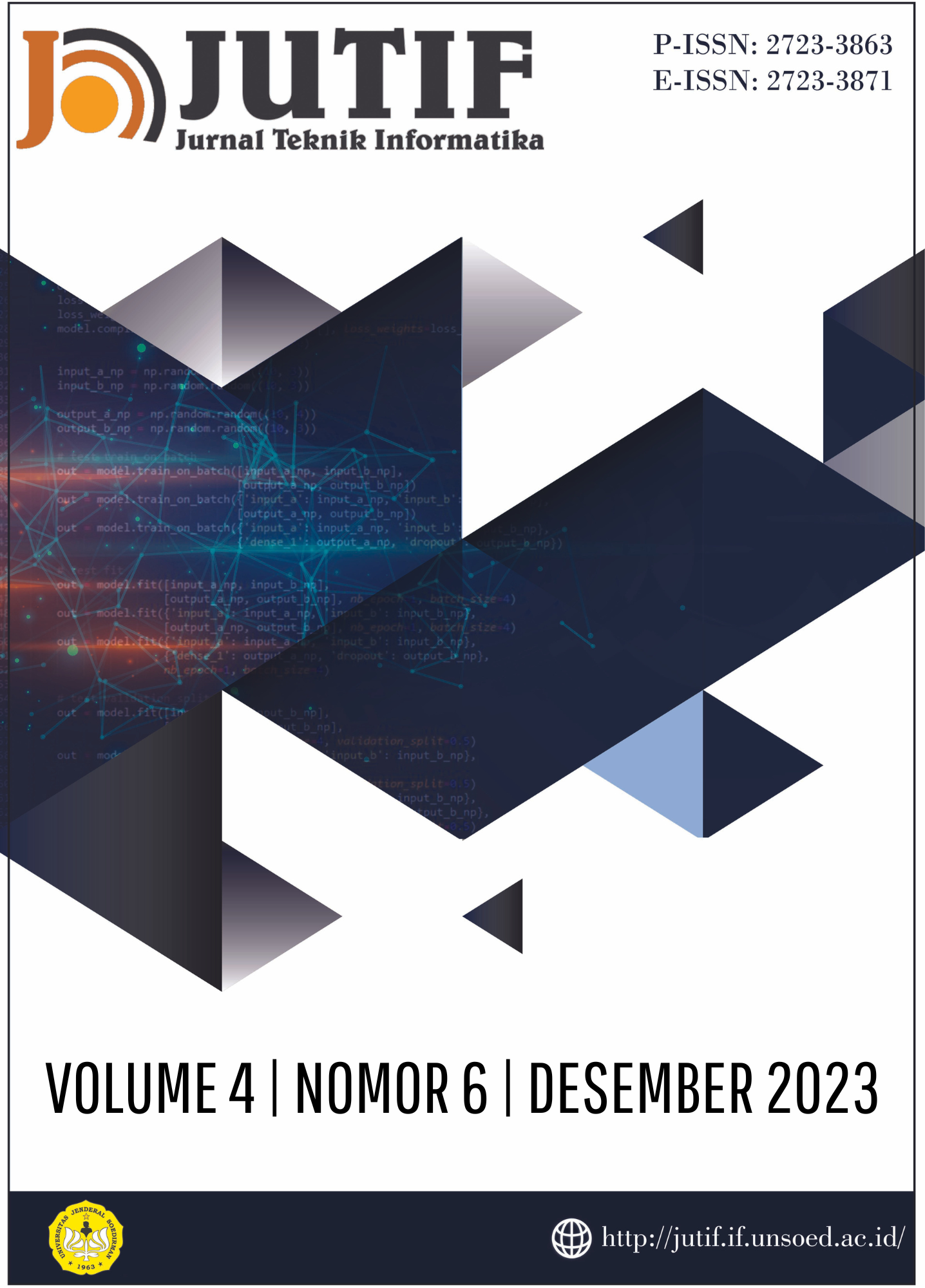ASSESSMENT OF INFORMATION SECURITY RISKS USE FUZZY INFERENCE MODEL (FIS)
DOI:
https://doi.org/10.52436/1.jutif.2023.4.6.1052Keywords:
Cyber Crime, Fuzzy Inference Model (FIS) Law, Information SecurityAbstract
Risk analysis is the process of systematically using information to identify and assess risks. This process how to analyze potential information security failure scenarios and the consequences of loss of confidentiality, integrity and preservation Availability of stored information values. Risk assessment is the process of comparing estimated risks against predetermined risk evaluation criteria to determine the level and priority of risk. This operation is performed using the retrieved data Risk analysis results for informed decision making future risk management measures; It is said that this cyber attack could lead to cyber warfare and cyber interference that disrupt national security and sovereignty. All of the above cyber threats are said to have the potential to threaten national assets. Institutions/companies around the world, especially those stored in his ISMS.
Downloads
References
I. P. Galang Persada Nurani Hakim, S.T., M. T., Ir.Diah Septiyana, S.T., M.T., I. P. P., Ahmad Firdausi, S.T., M. T., Fajar Rahayu Ikhwannul Mariati, S.T., M. T., & Dr. Ir. Setiyo Budiyanto, S.T., M.T., Sistem Fuzzy : Panduan Lengkap Aplikatif | Perpustakaan STIKOM Bali. 2021. [Daring]. Tersedia pada: http://library.stikom-bali.ac.id/10054/sistem-fuzzy-panduan-lengkap-aplikatif
C. T. Sanjaya, “Implementasi Logika Fuzzy Pada Aplikasi Pemasaran Udang Vaname Berdasarkan Skala Prioritas Di Ud. Mega Jaya Kab. Pacitan,” hal. 1–58, 2021, [Daring]. Tersedia pada: http://eprints.umpo.ac.id/id/eprint/7564
J. Al-kausar dan A. S. Handayani, “Perbandingan Type-1 Fuzzy Logic System ( T1FLS ) dan Interval Type-2 Fuzzy Logic System ( IT2FLS ) pada Mobile Robot,” Annu. Res. Semin., vol. 4, no. 1, hal. 978–979, 2018.
M. F. Saifuddien, “Implementasi algoritma Fuzzy type-2 untuk menentukan perilaku NPC dalam game Virtual Reality Survival Shooter,” hal. 1–100, 2018, [Daring]. Tersedia pada: http://etheses.uin-malang.ac.id/id/eprint/11023
A. M. Mohammed, E. I. Morsy, dan F. A. Omara, “Trust model for cloud service consumers,” hal. 122–129, 2018, doi: 10.1109/itce.2018.8316610.
P. S. D. Ragavendiran dan N. M. E. Sowmiya, “Analysis of Trust Score of CSPS by Comparing Service Broker Policies and Load Balancing Policies using Cloud Analyst and Fuzzy Inference System,” 2021, [Daring]. Tersedia pada: www.ijert.org
T. Jensen, M. M. H. Khan, Y. Albayram, M. A. Al Fahim, R. Buck, dan E. Coman, “Anticipated Emotions in Initial Trust Evaluations of a Drone System Based on Performance and Process Information,” Int. J. Hum. Comput. Interact., vol. 36, no. 4, hal. 316–325, 2020, doi: 10.1080/10447318.2019.1642616.
H. Kurdi et al., “A lightweight trust management algorithm based on subjective logic for interconnected cloud computing environments,” J. Supercomput., vol. 75, no. 7, hal. 3534–3554, 2019, doi: 10.1007/s11227-018-2669-y.
F. Topaloǧlu dan H. Pehlivan, “Comparison of Mamdani type and Sugeno type fuzzy inference systems in wind power plant installations,” 6th Int. Symp. Digit. Forensic Secur. ISDFS 2018 - Proceeding, vol. 2018-Janua, hal. 1–4, 2018, doi: 10.1109/ISDFS.2018.8355384.
A. K. Mehar dan S. Kotni, “A Study on Performance of Hydroxyapatite-Filled Polycarbonate and Polysulfone Composites Under Two-Body Abrasive Wear,” 2021. doi: 10.1007/978-981-15-7779-6_24.
S. De Capitani Di Vimercati, S. Foresti, G. Livraga, V. Piuri, dan P. Samarati, “A Fuzzy-Based Brokering Service for Cloud Plan Selection,” IEEE Syst. J., vol. 13, no. 4, hal. 4101–4109, 2019, doi: 10.1109/JSYST.2019.2893212.
D. Novitasari, M. Asbari, L. M. Wijayanti, C. C. Hyun, dan M. Farhan, “The Role of Religiosity, Leadership Style, Job Satisfaction and Organizational Citizenship Behavior Mediation on Woman Teachers’ Performance,” Solid State Technol., vol. 63, no. 6, hal. 2953–2967, 2020, [Daring]. Tersedia pada: http://solidstatetechnology.us/index.php/JSST/article/view/3380
R. P. Sharma, D. Ramesh, P. Pal, S. Tripathi, dan C. Kumar, “IoT-Enabled IEEE 802.15.4 WSN Monitoring Infrastructure-Driven Fuzzy-Logic-Based Crop Pest Prediction,” IEEE Internet Things J., vol. 9, no. 4, hal. 3037–3045, 2022, doi: 10.1109/JIOT.2021.3094198.
L. Van Der Werff, C. Real, dan T. G. Lynn, “Individual trust and the internet,” Routledge Companion to Trust, hal. 391–407, 2017, doi: 10.4324/9781315745572.
A. Orooji, M. Langarizadeh, M. Hassanzad, dan M. R. Zarkesh, “A Comparison Between Fuzzy Type-1 and Type-2 Systems in Medical Decision Making: A Systematic Review,” Crescent J. Med. Biol. Sci., vol. 6, no. 3, hal. 246–252, 2019.
A. Nhlabatsi et al., “Threat-specific security risk evaluation in the cloud,” IEEE Trans. Cloud Comput., vol. 9, no. 2, hal. 793–806, 2021, doi: 10.1109/TCC.2018.2883063.
F. Deng, Y. Li, H. Lin, J. Miao, dan X. Liang, “A bwm-topsis hazardous waste inventory safety risk evaluation,” Int. J. Environ. Res. Public Health, vol. 17, no. 16, hal. 1–18, 2020, doi: 10.3390/ijerph17165765.
D. Serdar, “Analisis Sistem Manajemen Keamanan Informasi Menggunakan Standar ISO/IEC 27001 Dan ISO/IEC 27002 Pada Kantor Pusat PT Jasa Marga,” Sustain., vol. 11, no. 1, hal. 1–14, 2019, [Daring]. Tersedia pada: http://scioteca.caf.com/bitstream/handle/123456789/1091/RED2017-Eng-8ene.pdf?sequence=12&isAllowed=y%0Ahttp://dx.doi.org/10.1016/j.regsciurbeco.2008.06.005%0Ahttps://www.researchgate.net/publication/305320484_SISTEM_PEMBETUNGAN_TERPUSAT_STRATEGI_MELESTARI.



























